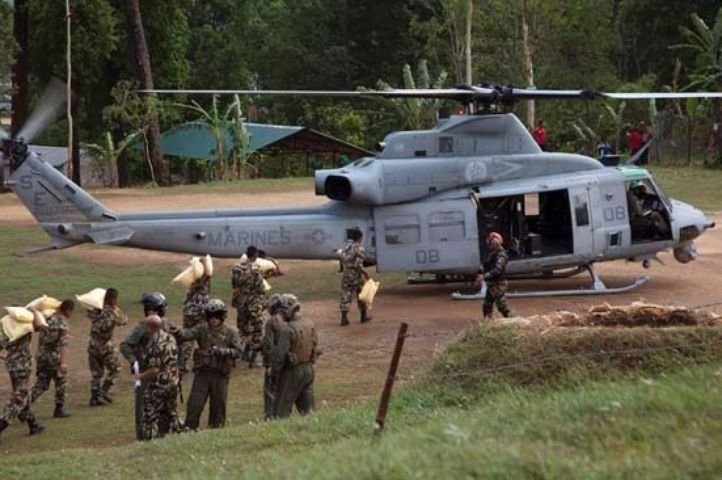As Nepal is still struggling to recover from a devastating quake nearly three weeks ago that left more than 8000 dead and thousands others injured, this mountain locked country continues to remain on the razor’s edge.
Most of the areas remain perilously unstable as landslides pose an ongoing threat that will further increase when seasonal monsoon rainfall begins in coming weeks. Another earthquake that hit the country on May 12 also caused three big landslides in some parts.
Geologists are rushing to identify the valleys, villages and towns most at risk from rock and mud falls, but resources are stretched as the country recovers from an April 25 quake that left a saga of haunting stories behind.

Diwakar Koirala , Deputy Administrator in Sindhupalchowk district, which reported the most deaths in last month’s disaster, said the May 12 quake caused three more big landslides. The risk of more landslides even prevented the authorities from heading to the affected villages for help.
Beyond the immediate emergency, some families will have to move to safer areas, a slow, costly process which Nepal can ill afford.
“There are some areas where it is very difficult to stay on a long-term basis, so we are looking at resettlement,” said Iman Gurung , a home ministry adviser, declining to specify which areas.
“We hope it’s not a big number,” Gurung said. “These villages have thousands of years of history. But we don’t want to put their lives at risk.”
Unsafe Areas
One of those moving may be Ram Tamang .
During the monsoon last August, he was out on a job driving when a wall of dirt and boulders crashed down a mountain at 2 AM onto the village of Jure, burying his wife, three of his children and his mother in their home.
Like many survivors, Tamang left the ruins of the village, and moved to a hamlet down the road. After last month’s earthquake sent rocks spilling down the mountain once again, he wonders where to go.
“It’s not safe here,” the 42-year-old said last week, before May 12 quake. “Last night, it was raining hard the whole night and I couldn’t sleep. I’m always worried another landslide will come.”

Among the areas worrying scientists most are those where landslides have fallen into rivers, potentially flooding nearby communities once the monsoon starts in earnest, probably in early June, scientists said.
In a report to the government last week, the International Centre for Integrated Mountain Development (ICIMOD) in Kathmandu identified six critical landslides that blocked rivers after the April 25 earthquake. Five are in Nepal and one in Tibet .
The water did not find its way through in Jure last year. After the landslide that killed most of Tamang’s family blocked the Sun Koshi River at the bottom of the mountain, a large lake formed that submerged village homes.
After the April earthquake, scientists at ICIMOD started to monitor landslides using satellite images sent from agencies in Japan , the United States , China and India . The group will keep watch on the six danger spots, including one in Langtang, where hundreds of people died in a huge landslide triggered by the quake.
In addition to thinking about whether, and where, to move people, officials said they were rushing to excavate blocked roads and deliver extra food to far-flung communities that will soon be cut-off by the rains.
Calculated risk
People living in Nepal ‘s mountains have long accepted the risk of landslides and floods.
Even before the latest earthquakes, they were on the rise as shifting weather patterns increased the chances of flooding from melting glaciers, more intense monsoon rains and the bursting of glacial lakes when their banks collapsed.

“These materials are highly unstable, and it doesn’t take much to knock them down and make a debris avalanche or landslide,” said Kargel.
Despite years of preparation for the next big earthquake, the government has been slow to map landslide-prone areas, said Bishal Nath Upreti , a retired geology professor and chairman of the Disaster Preparedness Network Nepal .
“It’s very hard to convince the government. They didn’t think it was so important,” Upreti said. “It’s urgent to start now.”
Even if danger areas are identified, people may not be able to move.
In Jure, several survivors, including Tamang, want to leave but don’t know where to go. They said the local government promised last year to help them relocate, but many still live under tarpaulins upon the landslide that destroyed their homes.
“Last year it was just one spot, now it’s the entire country,” said Bhim Bahadur Tamang , 40, who lost 11 family members in the landslide and one in last month’s earthquake.
“How are they going to (move us)?” he asked. “We don’t expect anything.”
Huey down
To add to Nepal’s problems the Nepali army has been told a missing US Marines helicopter with eight on board may have come down in a river in the Charikot area hit hard by an earthquake and 400 soldiers are engaged in the hunt, a senior officer said on May 13 .

“There are 400-plus of our ground troops looking for it also, by this evening, we might get it,” he said.
The Marine Corps UH-1Y Huey helicopter participating in earthquake relief operations lost radio contact on May 12, after its crew was heard talking about fuel problems.

















